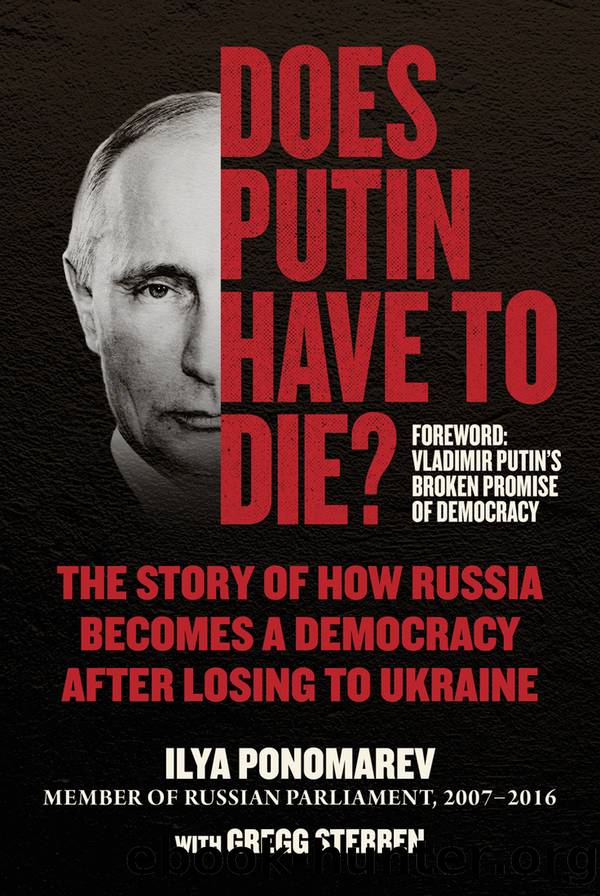Does Putin Have to Die? by Ponomarev Ilya;Stebben Gregg;

Author:Ponomarev, Ilya;Stebben, Gregg;
Language: eng
Format: epub
ISBN: 7099099
Publisher: Skyhorse Publishing Company, Incorporated
Published: 2022-05-15T00:00:00+00:00
CHAPTER ELEVEN
About Foreign Policy, War, and Nukes
One
In the early 2000s, Putin wanted to join NATO, and there were negotiations about it. The leadership of the alliance was amazed that the Kremlin wanted to participate as an equal partner with the United States while maintaining its own standards of military organization.
But NATO was created as an elite club led by the United States. Part of the deal with the Europeans was that they may not spend enough money on defense, but they must obey the guys from across the ocean who will protect them.
The Americans invested in the North Atlantic security system, and now they are not ready to share these investments with anyone. Quite logically, they instead want the retainers to be paidâeven 2% of the national budgets that are supposed to be allocated for defense purposes are usually paid by the newest members, the Eastern Europeans, who see the value in NATO but are pretty much ignored by the traditional member states. So now, when Ukraine asks for defense assistance, countries like Germany or France cannot really deliver anything seriousâtheyâve neglected to buy weapons for a long time.
It would have been funny if it werenât so sad. After the invasion began, Western Europeans started looking for producers to provide them with all different types of military equipment, only to realize those weapon manufacturers were long gone in âpeacefulâ Europe. As a result, not only tanks or cannons could not be produced, but also armored vests or riflesâthey lost all of that manufacturing capability. Frankly speaking, in Russia, the situation is not significantly better. Still, at least the Soviet Union left Putin a considerable legacy of hardware, which can be used in the fields of war for quite some time.
Western Europeans wanted a free ride. If Americans were so concerned about geopolitics, let them pay for it and provide the EU with military coverâbut without a second thought of who was in charge. Clearly, the worst-case scenario would have been the United States losing interest in protecting Europe, which almost happened under the Trump administration. However, nobody wanted to deal with problems before they emerged.
At the beginning of the 2000s, Russia was not ready for a significant financial commitment either. Yet since it was not really considered a threat anymore, even the temptation to put the Russian military and nuclear arsenal under joint command control did not produce enough appeal to NATO leadership.
Additionally, there was an issue with military standards, which were different. It was painful but feasible to enforce them on Poles or Czechs, but how to conform the entire Russian army, the second largest in the world? Obviously, if there were a political will, it would not become a deal breaker, but it was also an essential element in the decision process. Moreover, alliance members should not be competitors in the arms market. Russia is one of the largest arms producers in the world, and thatâs not going to change.
Taking all these factors in consideration, the West decided for the second time in its history that there was no place for Russia in NATO.
Download
This site does not store any files on its server. We only index and link to content provided by other sites. Please contact the content providers to delete copyright contents if any and email us, we'll remove relevant links or contents immediately.
| Arms Control | Diplomacy |
| Security | Trades & Tariffs |
| Treaties | African |
| Asian | Australian & Oceanian |
| Canadian | Caribbean & Latin American |
| European | Middle Eastern |
| Russian & Former Soviet Union |
The Secret History by Donna Tartt(16623)
The Social Justice Warrior Handbook by Lisa De Pasquale(11489)
Thirteen Reasons Why by Jay Asher(7788)
This Is How You Lose Her by Junot Diaz(5772)
Weapons of Math Destruction by Cathy O'Neil(5037)
Zero to One by Peter Thiel(4824)
The Myth of the Strong Leader by Archie Brown(4789)
Promise Me, Dad by Joe Biden(4447)
Beartown by Fredrik Backman(4418)
Stone's Rules by Roger Stone(4415)
How Democracies Die by Steven Levitsky & Daniel Ziblatt(4398)
The Fire Next Time by James Baldwin(4342)
100 Deadly Skills by Clint Emerson(4077)
A Higher Loyalty: Truth, Lies, and Leadership by James Comey(4032)
Rise and Kill First by Ronen Bergman(4012)
The David Icke Guide to the Global Conspiracy (and how to end it) by David Icke(3881)
The Farm by Tom Rob Smith(3872)
Secrecy World by Jake Bernstein(3782)
The Doomsday Machine by Daniel Ellsberg(3731)
